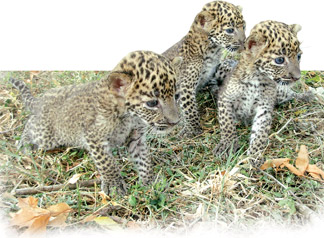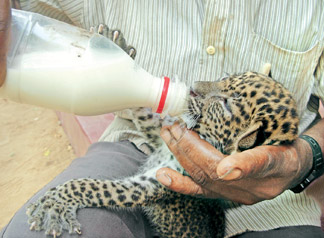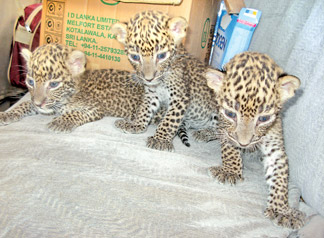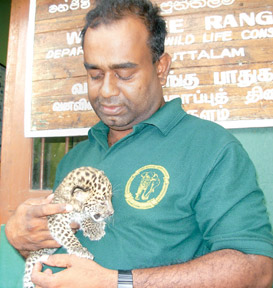Rescued leopard cubs in safe hands
By Dhaneshi YATAWARA
 The three leopard cubs rescued from an illegal trade in
Karuwalagaswewa in the Puttalam district recently was not just news but
a miracle that took place with the blessings of nature. The three leopard cubs rescued from an illegal trade in
Karuwalagaswewa in the Puttalam district recently was not just news but
a miracle that took place with the blessings of nature.
If the cubs were born two and a half months ago then July 1, the day
they were handed over to the Wildlife authorities would be their second
birth escaping a tragedy.
Today the three little cubs, all females are in the loving and caring
hands of the veterinarians of the National Zoological Gardens, Dehiwala.
Fate of cubs
Like their mother if they grow up in the wild they could have given
birth to more cubs to extend their family. Yet caught in the iron
clutches of animal poachers the cubs were about to be sold at a high
price through animal traffickers. Yet the fate of the little cubs was
not so unfortunate .
If elephants are the flagship species of Sri Lanka, leopards would be
our strength and superiority. Roaming in the thick jungles leopards
attract local and foreign wildlife enthusiasts to the wilderness in
search of this precious species of the country. Saving the lives of the
three leopard cubs early this month was a miracle for Sri Lanka which is
endowed with rich bio-diversity.
Karuwalagaswewa, the area where the cubs were to be illegaly traded
borders Sri Lanka's largest wildlife sanctuary, the Wilpattu National
Park. Wilpattu is globally renowned as one of the two Sri Lankan wild
life parks for this magnificent creature. The other location is the Yala
National Park. For the leopards, right to live safely in their natural
habitats is crucial for their survival.
 "When we received the cubs we assumed they could have been away from
the mother for few days less than a week. Luckily, they were slightly
dehydrated and they recovered well responding to our treatment," said
Veterinary Surgeon, Chandana Jayasinghe of the North Western Wildlife
region office of the Department of Wildlife Conservation. "When we received the cubs we assumed they could have been away from
the mother for few days less than a week. Luckily, they were slightly
dehydrated and they recovered well responding to our treatment," said
Veterinary Surgeon, Chandana Jayasinghe of the North Western Wildlife
region office of the Department of Wildlife Conservation.
The cubs find it difficult to suck milk from the bottle as from their
mother. According to veterinarians it could have been a struggle to
raise them in a domestic environment since the cubs were more used to
the natural environment. "To raise these cubs special treatment and care
by professionals are vital and essentially the veterinarians or the
animal caretakers should be 100 percent skilful to treat these wild
animals," Jayasinghe added.
Since the Zoological Garden in Dehiwala is equipped with facilities
to meet such a challenge the Wildlife Department handed over the three
cubs to the veterinarians of the zoo. The cubs are a lucky triplet.
The question is how could a priceless wildlife treasure be priced? It
is a national treasure and definitely not a personal wealth. The
uniqueness of this event is the number of cubs. "We rarely see a leopard
mother with three cubs. Mostly we have rescued either one or two cubs,"
Jayasinghe explained. The leopard mother would have never thought that
her uniqueness would bring tragedy to herself and her cuddly little
babies. According to animal experts a leopard mother would not leave her
cubs and she could be aggressive if the cubs are in danger. A poacher
must kill or trap her in order to take the cubs. The trapped leopard
mother will be killed for her beautiful skin.
Predator at risk
 Across the globe this agile and stealthy predator lives in a variety
of habitats including evergreen monsoon forest, arid jungle, low and
upper highland forest, rainforest, and wet zone intermediate forests.
According to the present nomenclature only nine sub species of leopards
are found in world. The Sri Lankan leopard, Panthera pardus kotiya is
unique among its own species. Since Carl Linnaeus published his
description of leopards in the 10th edition of Systema Naturae in 1758,
as many as 27 leopard subspecies were subsequently described by
naturalists from 1794 to 1956. Across the globe this agile and stealthy predator lives in a variety
of habitats including evergreen monsoon forest, arid jungle, low and
upper highland forest, rainforest, and wet zone intermediate forests.
According to the present nomenclature only nine sub species of leopards
are found in world. The Sri Lankan leopard, Panthera pardus kotiya is
unique among its own species. Since Carl Linnaeus published his
description of leopards in the 10th edition of Systema Naturae in 1758,
as many as 27 leopard subspecies were subsequently described by
naturalists from 1794 to 1956.
In 1996, according to DNA analysis carried out in the 1990s, only
eight subspecies are considered valid. Later analysis revealed a ninth
valid subspecies, the Arabian leopard. As scientists believe, because of
limited sampling of African leopards, this number might be an
underestimation.
The nine subspecies recognised by IUCN are, African leopard which
inhabits the sub-Saharan Africa, the Indian leopard that inhabits the
Indian subcontinent, Javan leopard inhabiting Java, Indonesia, Arabian
leopard which inhabits the Arabian Peninsula, Amur leopard which
inhabits the Russian Far East, Korean Peninsula and Northeast China, the
north Chinese leopard inhabiting the northern China, Caucasian leopard
which was later described as Persian leopard which is found in central
Asia: the Caucasus, Turkmenistan and northern Iran, the Indo-Chinese
leopard that inhabits mainland Southeast Asia and last but not the least
the Sri Lankan leopard.
Transition point
|

Veterinary Surgeon Chandana Jayasinghe examins a cub |
With South Asia identified as transition point for illegal animal
trade more threats emerge for these spotted beauties making their lives
harder. "To protect the leopard population it is essential to keep them
within the forest reserves which we are preserving for the animals,"
said Dr. Chandrawansa Pathiraja, Director General of the Wildlife
Conservation Department. By repairing the existing tanks and building
new minor tanks we are making water more abundant for the animals even
during the drought. This is important as animals tend to move to water
abundant areas that are outside the forest reserve. Thus they are prone
to danger", Dr. Pathiraja explained.
Maintaining ecological balance is important for the survival of these
carnivores, he added. According to the Director General the Department
is taking steps to provide fodder for herbivores identifying the typical
grasses and plants they prefer. Saving every animal in the wilderness is
crucial for the survival of these top predators.
This endangered stealthy predator needs healthy animals in the
forests as the maintenance of the food chain is vital for the survival
of the forest eco system.
With peace restored especially in the Northern and Eastern provinces
it is essential to educate the resettled communities on how to raise
their cattle, grow crops and carry out their livelihood activities
without disturbing the natural habitats of the wildlife. Through the
eyes of the little cubs understand the fate of their mother and their
entire brood. Every citizen is duty bound to protect this unique wealth
of the nation.
|

